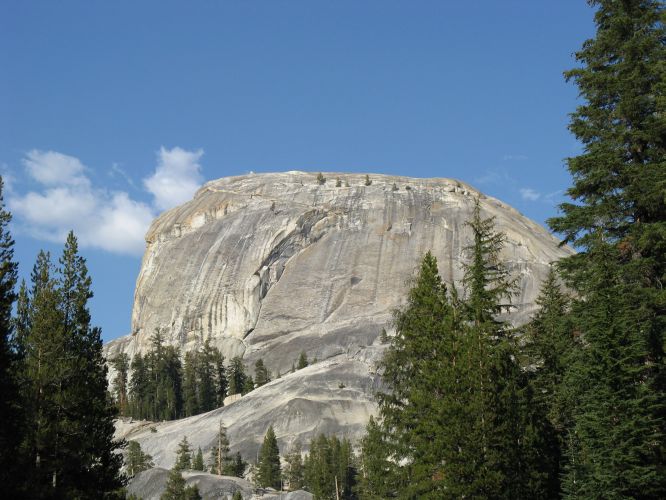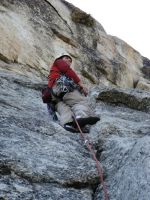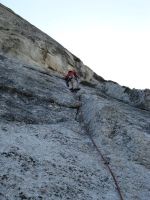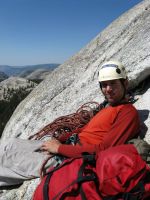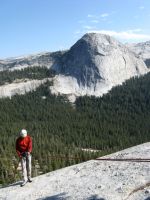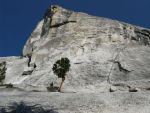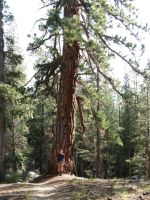|
This impressive formation deserves a better name than the whimsical Dome Across
From Fairview.
The blank looking West Face is split by West Crack, which offers exciting and varied climbing.
It also features a number of face climbing routes. Getting off of Daff Dome is a bit tricky.
Make sure you walk east-southeast for a while to find the tell-tale tree that signals the rap
anchors.
Topo Map
(Daff Dome is Point 9,153)
Routes: West Crack (I, 5.9)
 Blown Away (I, 5.9)
Blown Away (I, 5.9)
|
Daff Dome in September from the Southwest
|
| |
|
Date: September 14, 2008
Party: Paul and Dietrich Belitz
Route: West Crack
Equipment: Alpine rack to Camalot #5
Time: 2 hours 30 mins (on the route)
Comments: Time is pure climbing time. We spent 90 minutes waiting in line on the
first pitch. Allow an hour for the descent after finding the
rap anchors.
Trip report:
After a day of cragging, we were looking for another multi-pitch climb on our last day.
We thought about Matthes Crest, but dismissed it since we did not feel liking getting
up early enough for the long approach. We thought about the Regular Route on Fairview,
but figured we should do it some day earlier in the season, as the mornings were already
very cold. So we settled on West Crack on Daff Dome, which sounded very interesting, and
we did not get disappointed.
By the time we arrived there were two parties ahead of us, and shortly thereafter tree more
parties showed up to stand in line. Paul started up the first pitch, against my advice, as
soon as the leader of the party ahead of us left the first belay, only to hang out in the
middle of the first pitch for almost 90 minutes, as there was an unbelievable traffic jam
somewhere on the second pitch. By the time he finally got to the first belay it was noon, and
the sun had just reached the base of the climb, so I took off my belay jacket and followed
him. The 5.9 start was not too bad, and the crack that followed was easier than I expected,
but the finish of the pitch turned out to involve some tricky face climbing that was harder
than I had anticipated, and I was appalled to see that Paul had run out the last 25 or so feet.
The next pitch was mine, so we re-racked and after some contemplation I started on the
overhanging 5.8 section. This turned out to be remarkably burly, and even though I could
reach the jug on the left without much problems (beats me what short people do there), I
felt a bit insecure pulling up after high-stepping with my right foot. It felt very hard
for 5.8, but Paul later told me I did not find the right sequence. The next 30 feet were
easier and well protected. I found the bolt to the left, clipped it with a long sling,
and went back down to retrieve a #3 Camalot that I figured might come handy later. Next
came the off-width, which is not quite as wide as I expected. I placed Paul's #5 Camalot,
but a #4 would have sufficed. The knobs to the right of the offwidth are amazing, and
this section is a lot of fun. After a while the offwidth turned into a finger crack, and
as I had gone for only a bit over half a rope length, and rope drag was not an issue, I
decided to keep going. The finger crack is truly remarkable: 5.7 fingers with some face relief
turn into 5.8 fingers with no face relief, and this keeps going for almost 100 vertical
feet. By the time I could see the next ledge I was nearly out of gear, my
toes hurt from lots of toe jams,
and I also figured I was very close to the end of the rope. I had lost audio contact with
Paul, so I could not be sure, but I had guessed correctly: After building an anchor for a
hanging belay, I pulled up only a few feet of rope. Paul followed, and he was as impressed as I
was. Too bad I did not have a camera handy, we missed an incredible photo opportunity there.
Paul led through, and another 60 feet got us to the ledge. It turns out the finger crack
peters out just below the ledge, but miraculously at the same point a second crack starts
just a few feet to the right. We had a lunch of nuts and berries on the ledge, soaked in
the sun for a while, and enjoyed the view. Paul then led the last pitch on much easier
terrain, and soon we were on the summit that is decorated with lots of cairns and sports
a fabulous view of Fairview Dome.
When it was time to go down, we had a hard time finding the rap anchors. We searched forever
in the vicinity of the trees just below the summit, none of which were obviously larger than
the others, without any success. Finally we gave up, decided to go for the infamous polished
walk-off, and started down the line of least-steep descent to the Southeast. After a while,
the top of a tree came into view, a few feet lower we could see that it was a fairly large
tree, and yet a few feet lower there was a block right by the tree. Sure enough, that was
the block with the rap anchors. One short low-angeled rappel was followed by a free-hanging
rappel, and from there on there was an obvious trail down. We walked around to the base of
the climb to retrieve our sneakers, went back to the car, and proceeded to Tenaya Lake where
we were to meet Monica who had gone on a long hike.
It was a very nice and very impressive climb. We felt that now we were prepared to tackle
Fairview, but unfortunately we had to leave the next day. So we'll have to come back and
do Fairview, which is just as well, as Tuolomne is just amazingly nice.
Photo Gallery:
Click the thumbnails to see a higher resolution image
|
Paul on the first pitch waiting for the traffic jam to clear. |
Paul leading the first pitch. |
Paul on the big ledge. |
Paul rappelling. |
View back on the route from the descent. |
Big ponderosa pine along the trail. |
 Blown Away (I, 5.9)
Blown Away (I, 5.9)
